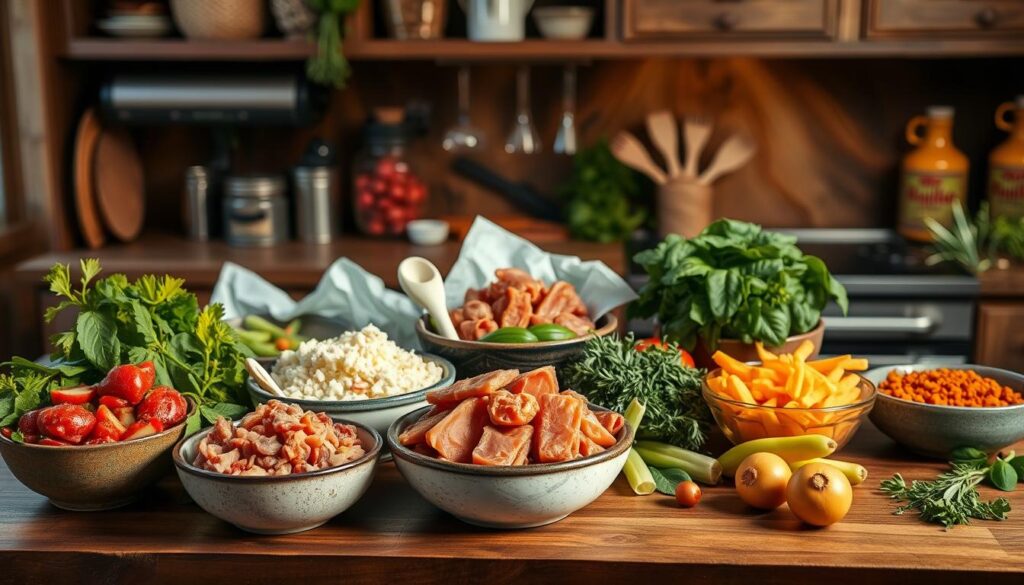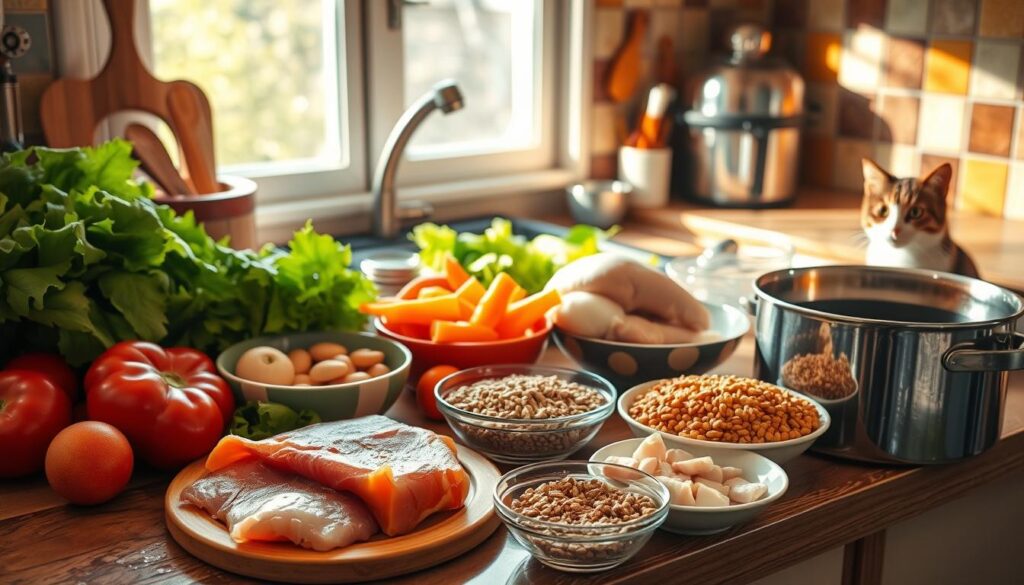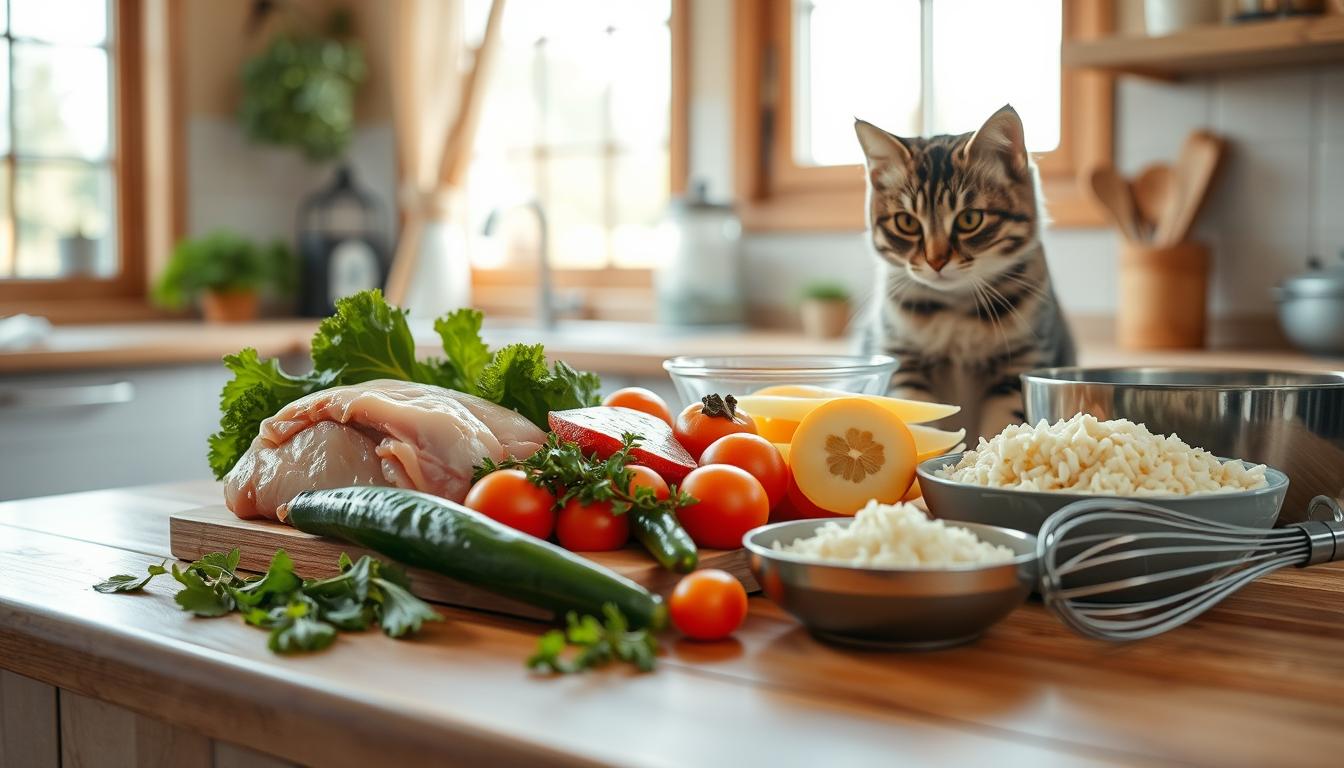Thinking about my cat enjoying a homemade meal makes me happy. It’s exciting to make food that they love. This guide will help you make tasty, healthy meals for your cat.
Homemade cat food is popular for many reasons. It lets you choose what goes into their meals and can save money. We’ll explore how to pick the right ingredients for your cat’s diet. This way, you can make sure your cat gets the best food.
Table of Contents
Understanding Basic Cat Nutrition Requirements
As pet owners, it’s key to give our cats a balanced diet. Cats need a lot of animal-based proteins to stay healthy. Knowing what nutrients your cat needs is the first step to making homemade cat food.
Essential Proteins for Cats
Cats need certain amino acids like taurine and arginine. Without these, they can get very sick. It’s important to use high-quality animal proteins in your homemade cat food.
Vital Vitamins and Minerals
Cats also need vitamins and minerals for health. Vitamins A, D, and B-complex are very important. Minerals like calcium and potassium are also crucial. Making sure your homemade cat food has these nutrients is vital.
Importance of Fats in Feline Diet
Fats give cats energy and help them absorb vitamins. They should make up about 20-24% of their diet. But, it’s important to choose healthy fats and not too much.
By knowing what cats need, you can make homemade cat food that’s just right for them. This ensures they get the nutrients they need for a healthy life.
“Proper nutrition is the foundation for a healthy, happy cat. Understanding your cat’s dietary needs is the first step in providing them with a balanced, homemade diet.”
Benefits of Preparing DIY Cat Food at Home
Creating homemade diy pet food for your cat has many advantages. It lets you control what goes into their meals. You can also tailor their diet to their health needs and likes.
One big plus of natural cat cuisine is avoiding bad stuff in commercial food. You can use fresh, quality ingredients. This means your cat gets a diet full of nutrients they need.
Homemade cat food can also save you money. It might cost more upfront, but it can lower vet bills. This is because your cat is eating better and staying healthier.
Homemade food also means your cat can enjoy different tastes. This can help them not get bored with their food. A happy cat is a healthy one!
| Benefit | Description |
|---|---|
| Quality Control | Ability to choose high-quality, fresh ingredients and avoid fillers and preservatives found in some commercial pet foods. |
| Customization | Tailoring meals to your cat’s individual preferences and health needs, such as addressing dietary sensitivities or special requirements. |
| Cost-Effectiveness | Potential long-term savings on veterinary bills due to improved health and reduced risk of dietary-related issues. |
| Palatability and Digestibility | Fresh, high-quality ingredients may enhance the taste and ease of digestion for your cat, leading to better overall nutrition. |
Preparing diy pet food at home is great for your cat’s health. It lets you make sure they get the nutrients they need. Plus, it strengthens your bond with them.
Homemade Cat Food Recipes for Beginners
Looking for a healthier option for your cat? Homemade cat food recipes are a great choice. They use high-quality animal proteins as the main ingredient. This ensures your cat gets the nutrients they need for good health.
Beefy Barley Delight
This recipe mixes cooked beef, egg yolk, and barley powder. It’s a nutritious meal for your cat. The beef is a rich protein source, and the egg yolk adds extra nutrients. The barley powder helps with digestion.
Simple Chicken and Fish Mix
This homemade pet treats recipe combines chicken and fish. It offers your cat lean proteins from two high-quality sources. This mix ensures your cat gets a balanced diet.
Protein-Rich Turkey Recipe
For a leaner protein option, try the turkey recipe. Turkey is a low-fat, highly digestible meat. It’s a great source of protein for your cat’s health.
When making homemade cat food, always talk to your vet. They can help make sure the recipes meet your cat’s dietary needs.
Raw vs. Cooked Cat Food: Making the Right Choice
As a cat parent, you want the best for your feline friend. The debate between raw and cooked homemade cat food is complex. The right choice depends on several factors.
Raw diets are loved for keeping more nutrients that cats need. They offer a natural diet close to what cats ate in the wild. But, raw meat can be risky due to bacteria, needing careful handling.
Cooked cat food is safer and easier for some owners. Cooking kills bacteria but might lose some nutrients. It’s a worry-free way to feed your cat.
Choosing between raw and cooked food depends on your cat’s health and your preferences. Your vet’s advice is crucial. Both can be balanced for your cat’s needs with the right ingredients.
| Raw Cat Food | Cooked Cat Food |
|---|---|
| Preserves more essential nutrients | Safer and easier to prepare |
| Requires careful handling to avoid bacterial contamination | Some nutrients may be lost during the cooking process |
| Mimics a cat’s ancestral diet | Provides a more accessible meal preparation experience |
The choice between raw and cooked feline diet depends on your cat’s needs and your comfort. By weighing the pros and cons, you can choose the best natural cat cuisine for your cat.

“A balanced homemade diet, whether raw or cooked, can provide your cat with superior nutrition compared to commercial pet food options.”
Essential Ingredients for Balanced Cat Meals
Making healthy cat meals means picking the right ingredients. These should meet your cat’s special dietary needs. Whether you’re new to making cat food or have been doing it for a while, knowing what’s important is crucial. It helps keep your cat healthy and happy.
High-Quality Protein Sources
Cats need a lot of protein from animal sources. This is because they are meat-eaters. Good protein sources include:
- Chicken
- Turkey
- Beef
- Sardines and other fatty fish
Healthy Fat Options
Fats are important for cats, giving them energy and helping them absorb vitamins. Healthy fats to add are:
- Fish oils (e.g., salmon, cod liver)
- Egg yolks
- Animal fats (e.g., tallow, lard)
Necessary Supplements
To make sure your cat gets everything they need, add these supplements:
- Taurine: Important for heart and eye health
- Calcium: Helps with strong bones and teeth
- Vitamin E: Boosts the immune system
Adding organ meats can give your cat extra vitamins and minerals. But, make sure to avoid foods that are bad for cats, like onions, garlic, and some fish.
“Giving your cat balanced, nutritious cat meals is key to their health and happiness.”
Common Mistakes to Avoid When Making Cat Food
Making homemade cat food can be rewarding, but it’s important to avoid mistakes. These can harm your cat’s health. Learn from homemade cat food recipes to keep your cat healthy and happy.
One big mistake is not adding taurine to the food. Cats need animal proteins and certain vitamins and minerals. Without taurine, they can get heart problems, blindness, and even die.
- Not balancing calcium and phosphorus is another mistake. These minerals are key for strong bones and teeth.
- Using too many plant-based foods is also wrong. Cats mainly need animal proteins.
- Adding toxic foods like onions, garlic, and chocolate is a big no-no. These can harm or kill cats.
It’s smart to talk to a vet or pet nutrition expert. They can help make sure your cat’s diet is right for them.
“Homemade cat food can be great, but you must do it correctly. Avoid common mistakes and get help from your vet to ensure your cat’s meals are balanced.”

Remember these tips and get advice from experts. Your cat will be healthier and happier because of it.
Storage Tips and Food Safety Guidelines
Preparing diy pet food at home for your cat is rewarding. But, it’s key to follow storage and food safety tips. Knowing how to handle and keep your homemade healthy cat snacks right ensures your cat’s meals stay fresh and nutritious.
Proper Storage Methods
After making homemade cat food, store it right. Use airtight containers in the fridge for up to 3 days. For longer storage, freeze in portions. Use freezer-safe containers or bags to keep food fresh.
Safe Handling Practices
Good food safety is crucial when making homemade cat meals. Always wash hands, utensils, and surfaces before and after handling food. Thaw frozen food in the fridge, not at room temperature. Discard any uneaten wet food after 30 minutes to avoid spoilage.
Shelf Life Guidelines
Homemade cat food’s shelf life is limited. Refrigerated food lasts up to 3 days, while frozen portions can last 3 months. Always check for spoilage signs before serving your cat.
By following these guidelines, you can keep your diy pet food and healthy cat snacks safe and fresh. Always talk to your vet if you have dietary concerns for your cat.
Special Dietary Considerations for Different Cat Life Stages
Every cat is different, and their diet needs change as they grow. Knowing what your cat needs at each stage is key to their health and happiness.
Kittens need lots of protein, fat, and calories to grow fast. Adult cats need a balanced diet with the right feline diet ingredients. Senior cats do well on diets that are easy to digest and have more protein to keep their muscles strong.
Pregnant and nursing cats need more calories, protein, and nutrients. These are vital for the health and growth of their kittens. Talking to a vet can help you make the right homemade cat food for your cat’s needs.

